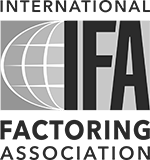Ultimate Factoring Encyclopedia
Invoice factoring – a major pressure lift for your cash flow.
Invoice factoring provides advances on average up to 85 per cent of an invoice’s value upfront, with the remainder paid back minus fees after payment is received from the client.
Funding is not dependent on the customer’s balance sheet, creditworthiness or their existing time in business — which makes it an incredibly flexible funding option.
For those considering invoice factoring, we’ve created the Ultimate Factoring Encyclopedia to help you understand the process and commonly used terminology. Discover the terms you’ll come across with invoice factoring and get a head start on the process.
Why companies need invoice factoring.
Cash flow issues can threaten the very existence of a business, but they’re a fact of life for virtually all businesses at one time or another. Expenses need to be paid, but customers can take up to 30 or 60 days (or longer) to pay for goods or services you’ve already delivered. And borrowing from the bank isn’t always an option.
Who should consider invoice factoring?
B2B companies with creditworthy debtors that bill customers with an average invoice term of 30 to 60 days, yet don’t qualify for traditional bank financing due to length of time in business, historical profitability, and even sharp changes in growth, might want to consider invoice factoring to help manage the cash-flow gap.
How does invoice factoring work?
Invoice factoring is the process of selling your invoices to a financial company, known as a factor. After checking the creditworthiness of your customers and verifying the invoices, the factor advances the value of the invoices, less a reserve. When the factor collects the invoices, they forward the reserve to you, minus the agreed upon factoring fees.
What are the key benefits of invoice factoring?
Invoice factoring is a proven and reliable way to access working capital fast. You’ve done the work or provided the service — you’re entitled to the revenue from your customer invoices. With factoring, you’ll access capital faster than waiting for the payment from your customer and can advance your business initiatives.
What’s in a name?
Factoring is commonly referred to as:
- Invoice factoring
- Invoice discounting
- Accounts receivable factoring
- Accounts receivable financing
- A/R factoring
They’re all the same thing, just with slight variations on the name. Companies that offer these services are called “factors” and they are funding sources that agree to pay a business the value of their incoming invoice(s) up front, minus a discount (also known as a reserve fee) in return for their commission and fees.
Invoice Factoring definitions
Make sure you can ‘speak the right language’ with any invoice factoring provider.
The ins and outs of invoice factoring, term by term.
A
B
C
D
E
F
G
I
L
M
N
P
Personal Property Security Act (PPSA)
R
S
Statement of Retained Earnings
U
Universal Commercial Code (UCC)
V
W
Account Debtor
This the customer responsible for paying an account. In factoring, the account debtor is the customer who purchased goods or services from the firm selling the invoice to the factor.
Accounts Receivable
The money owed to a firm for goods or services that have been delivered. Accounts receivable are recorded as a current asset on the balance sheet of the firm that delivered the goods or services.
Accounts Receivable Factoring
Another name for factoring. See “Factoring” in definitions list.
Advance
The money the factor pays the client at the time it buys the invoice. This is a percentage of the full value of the invoice.
Advance Factoring
A type of factoring in which the factor pays the client a portion of the full value of the invoice prior to the invoice payments being realized. This differs slightly from maturity factoring; see “Maturity Factoring” below.
Advance Rate
The percentage of the invoice that is advanced by the factoring company. This typically ranges from 70 to 90 per cent.
Asset-Based Loans (ABL)
Commonly referred to as ABL, this is a type of loan where an asset such as marketable securities or real estate is pledged to the lender, who can sell the asset if the loan is not repaid. The value of the loan is primarily based on the value of the pledged asset. Learn more about Asset-Based Loans here.
Assets
Tangible or intangible property having economic value that is owned or controlled by a firm.
Audit
An official inspection of the accounts of an organization or individual. A “Factor” may audit the procedures and accounts of a client prior to entering into an agreement and on an ongoing basis.
Bad Debt
Debt that is unpaid and deemed uncollectible.
Balance Sheet
Part of your financial statements, this is a snapshot of the financial position of the firm on a given date, showing assets, liabilities and shareholders’ equity.
Bank Participation Factoring
Factoring where a bank advances funds against the factoring reserves. For example, if a factor advances 80 per cent of the invoice value and the bank will advance 50 per cent of the reserve value, then the bank will advance 10 per cent of the invoice value.
Blind Notification
Another term for “Non-Notification Factoring.”
Business Interests
Involvement in, or legal rights to, a business.
Cash Flow
The net money flowing into and out of a business.
Cash Flow Statement
Also called a “Statement of Cash Flows,” this is part of your financial statements. See how to create your cash flow budget here.
CDs
See “Certificate of Deposit” below.
Certificate of Deposit
A type of savings account with a set maturity date and rate of interest. After the initial deposit, withdrawals and deposits cannot be made prior to maturity. The maturity dates typically range from three weeks to five years and the interest rate is usually higher than that paid by a standard bank account. Also known as CDs.
Client
In factoring, a term commonly used to denote the seller of the invoices to the factor.
Collateral
Assets that are pledged by a borrower against a loan. If the borrower defaults, the lender can sell the collateral to raise the money owed.
Collateral Mortgage
A mortgage where the property being mortgaged is registered with a collateral charge rather than with a mortgage charge at the land title or municipal registry office. A collateral mortgage allows for additional money to be lent against the property as the property value increases, without the need for new financing. A collateral mortgage cannot be transferred from the lender.
Collections
Payments the factor receives on the invoices that have been factored.
Collection Factoring
Another name for maturity factoring. See “Maturity Factoring” below.
Contingent Liability
A potential liability that may become an actual liability depending on the uncertain outcome of a future event. Examples include pending lawsuits and honoring product warranties.
Credit Risk
The probability of loss arising from a borrower not paying back part or all of a loan.
Creditworthy Organization
An organization considered safe to lend or extend credit to because it’s expected they will honor the obligation. Creditworthiness is based on factors such as past payment history, business credit score, current business standing and collateral.
Cross-Border Factoring
Factoring when the client (exporter) and the customer (importer) are not in the same country, and the domestic factor works with a factor in the other country to collect from the customer (importer). In this case, there are four parties in the transaction: the importer, the exporter, the import factor and the export factor.
Customer
In factoring, this is a term commonly used to refer to the invoice debtors who are the customers of the client.
DBA/Trade Name
DBA stands for “doing business as.” It is the name of the business as it is commonly known or operates under rather than its legally registered name.
Default
Failure to repay a loan.
Disclosed Factoring
Factoring where the factoring arrangement is made known to the invoice debtor (the customer).
Discount Fee
Another term for the factoring fee. See “Factoring Fee” below.
Discounted Cash Flow
A method used to value an investment by discounting its future expected cash flows to find their value today, or net present value. The discount rate is chosen to reflect the risk of the investment. Possible discount rates are the weighted average cost of capital or the discount rate from similar projects.
Domestic Factoring
This occurs when the factor, client and customer are all in the same country.
D-U-N-S Number
This number identifies a company’s Dun & Bradstreet business credit file. Dun & Bradstreet is a corporation that provides commercial credit information. The D-U-N-S Number allows you to proactively add your most current information to Dun & Bradstreet’s records. It is used by lenders to predict if you are a reliable and financially stable company, and is an easier method for them to find your credit information. Learn more about requesting a D-U-N-S number here.
Event of Default
An occurrence predetermined in a loan agreement that allows the creditor to demand immediate full payment of the loan or seizure of the collateral. Examples include missed payments, a specified decline in the financial condition of the borrower or the borrower experiencing a material adverse event.
Facility Amount
The total amount of borrowing allowed by a credit facility. A credit facility is a type of loan extended for a given period that allows the borrower to access money when they need it during the term of the facility, in the amounts they need, subject to all borrowings not exceeding the total facility amount at a given time.
Factor
Another name for a factoring company. See “Factoring Company” below.
Factoring
A financial transaction in which a company finances its unpaid invoices by selling them at a slight discount for immediate cash to an intermediary, known as a factor. See more details here.
Factoring Company
A financial company that specializes in buying unpaid invoices from other companies at a discount and then collecting the unpaid balances. A factoring company is commonly referred to as a “factor.”
Factoring Fee
The fee charged to the client by the factoring company to finance the client’s invoice. This is deducted from the reserve that is paid to the client. It is typically stated as a percentage of the gross invoice amount per time period (i.e. 2% for 30 days).
A tiered arrangement is most common, so on a $10,000 invoice the fee might be $200 if the invoice is collected within 30 days, $400 if collected within 31 to 60 days and $600 if collected within 61 to 90 days. A flat fee is when one rate is charged regardless of time to collect. If the flat rate is 4% and the invoice is $10,000, then the fee will be $400 whether the invoice is collected on day one or day 90.
Sometimes the rate will be stated as prime plus. In this case, the percentage used for the fee will be the prime rate plus a percentage, and the fee will work like an installment loan with interest accruing as long as the invoice balance is outstanding. If the prime rate changes, the rate charged to the client will also change.
Financial Statements
A summary-level formal record of the financial activities of a company. The financial statements are comprised of four separate reports:
-
- Balance Sheet: A snapshot of the financial position of the firm on a given date, showing assets, liabilities and shareholders’ equity.
- Income Statement: Shows income, expenses and net profit or loss over a specified period.
- Statement of Cash Flows: Shows the movement of cash over a specified period, also called a Cash Flow Statement. See how to create your cash flow budget here.
- Statement of Retained Earnings: Shows the movement of shareholders’ equity over a specified period.
Full Factoring
Also known as conventional factoring or old-line factoring. This is advance, non-recourse factoring where the factor performs all the services of factoring including financing, collections, sales ledger administration and credit protection. It also involves the factor buying all eligible invoices from the client and factoring them on a continuous basis.
Full Guarantee
See “Guarantees” definition for the complete description. A full guarantee, also called a personal guarantee, allows the factor to go after a client’s personal assets, not tied to the business, in the event of a default.
Funding Limit
The maximum amount of money a factor can provide to a client. Also referred to as “Maximum Amount.”
Funding Period
The time from when the factor buys the invoice from the client to when the customer pays the invoice in full.
Guarantees
A guarantee is a formal promise to pay the debt or perform the obligation of another party in the case of default by that party. There are three types of guarantees relevant to factoring: personal, vendor and validity.
A personal guarantee, also called a full guarantee, allows the factor to go after a client’s personal assets, not tied to the business, in the event of a default.
A vendor guarantee occurs when a company gets a large order but can’t afford to buy the supplies to fulfill it. The factor that is assigned the invoice for the order will guarantee payment to the vendor or pay the vendor out of the advance. Also called “Suppliers Guarantee Factoring.”
When a client makes a validity guarantee they warrant that their invoices are collectible, that they have not been pledged to another company and that they are valid. They also promise to forward misdirected payments to the factor. The owner’s personal assets are not tied to this guarantee.
Initial Rate
The minimum discount rate charged by the factoring company when the discount rate is adjustable. For instance, the factoring company may charge a rate of 2% for invoices collected within 30 days and then an additional 1% if the invoice is paid between the 31st and 60th days. The initial rate in this case is 2%. That means for a $10,000 invoice you would be charged $200 if the invoice was paid in the first 30 days, but $300 if the invoice was paid between the 31st and 60th days.
Initial Rate Period
The period during which the initial rate applies. For instance, the first 30 days.
International Factoring
International factoring is a form of financing that gives business owners the ability to offer open credit terms to foreign buyers. These buyers may be companies you would not normally be able to sell to, or feel comfortable selling to without a traditional deposit. See more details here.
Income Statement
Part of your financial statements, this shows income, expenses and net profit or loss over a specified period.
Invoice Debtor
The customer responsible for paying an invoice.
Invoice Discounting
A form of invoice financing where the lending is against the entire sales ledger and the financing company does not ledger or track individual invoices. It is a funding-only solution that is typically only available to larger companies. The client retains control of the sales ledger and collects the invoices, and the account debtors are not made aware of the financing arrangement.
Invoice Factoring
Another term for factoring. See “Factoring” above.
Lien
A registered legal claim on a person’s property granted to a lender or other party to secure a debt or other obligation.
Maturity Factoring
A type of factoring agreement where the factor does not pay an advance to the client but pays the client on the maturity of the invoice or the date of collection of the invoice. Also known as “Collection Factoring.”
Maximum Amount
Another term for funding limit. See “Funding Limit” above.
Non-Notification Factoring
A type of factoring where the customer is not made aware of the factoring arrangement. This is accomplished through means such as having the factor communicate with customers using client letterhead and having invoice payments go to a lockbox. Also known as “Blind Notification.”
Non-Recourse Factoring
A form of factoring where the factor agrees to absorb credit losses from defaults on invoices. The types of losses that will be absorbed are outlined in the factoring agreement. The most common type of credit loss covered is that resulting from the bankruptcy of a customer. Also known as “Without Recourse Factoring.”
Notice of Assignment (NOA)
A legally binding notice sent to customers to inform them of the factoring arrangement and the new payment instructions.
Notification
The process of notifying the invoice debtor (customer) of the factoring arrangement and telling them that they are to pay the factor directly. Typically formalized by the mailing of a notice of assignment.
PO Financing
Another name for “Purchase Order Financing.” Learn more about PO financing here.
Personal Guarantee
See “Guarantees” definition for the complete description. A personal guarantee, also called a full guarantee, allows the factor to go after a client’s personal assets, not tied to the business, in the event of a default.
Personal Net Worth
What a person owns (their assets) less what they owe (their liabilities).
Personal Property Security Act (PPSA)
Statutes passed in all the common law provinces and territories of Canada that provide the rules for when personal property is used as collateral to secure a debt. Lenders will file “Security Registrations” against your company to help guarantee you make payment, and it is important to ensure the filings are correct and up-to-date. See how to perform a PPSA search here.
Power of Attorney
A legal document authorizing a person to act on behalf of another in legal, personal and business matters.
PPSA Search or Registration
A registration with the applicable province by a creditor of a lien on the property of a debtor. See “Personal Property Security Act” above.
Prime Plus
Sometimes the factoring fee rate may be stated as “prime plus.” In this case, the percentage used for the fee will be the prime rate plus a percentage, and the fee will work like an instalment loan with interest accruing as long as the invoice balance is outstanding. If the prime rate changes, the rate charged to the client will also change. See more on “Factoring Fees” with examples above.
Purchase Order Financing
Also known as “PO financing,” this is a type of funding used when a firm receives an order from a client but does not have the money to pay the supplier for the goods necessary to fulfill the order. The purchase order finance company will forward the funds to the supplier, who will deliver the goods to the end customer. The finance company will then collect payment from the end customer (often through an invoice factoring agreement) and forward the borrowing firm the profits from the transaction, less the fees charged by the purchasing order financing firm. Learn more about Purchase Order Financing here.
Recourse Factoring
A form of factoring where the factoring company does not absorb any credit losses and the client is liable for payment of defaulted invoices.
Replacement Account
In a factoring agreement, it may be stipulated that if an invoice (account) sold to the factor is not paid, the client may replace that invoice (account) with one having equal or higher face value.
Reserve
In a factoring transaction, this is the amount of the total invoice value that is held back (not advanced) in order to cover any chargebacks. When the client pays the invoice, the factor will forward the reserved funds to the customer minus the factor fees.
Sales Ledger
A detailed record of a company’s sales and the amounts paid and owed by customers.
Schedule of Accounts
A report given by the client to the factor when submitting invoices for factoring, which shows the customers, amounts owing and due dates of the invoices.
Security Registration
Security registrations are filed by lenders or creditors to help guarantee you make your payments, often using personal property as collateral. These are common in the world of lending, and once your debt is paid off the record is discharged. See “PPSA Registration” and “UCC Registration” for more information. Learn how to double-check security registrations filed against your company here.
Spot Factoring
A factoring transaction where the factor buys a single invoice from a client in a one-time purchase. The relationship between the factor and the client ends when the invoice is collected.
Statement of Cash Flows
Part of your financial statements, this shows the movement of cash over a specified period, also called a Cash Flow Statement.
Statement of Retained Earnings
Part of your financial statements, this shows the movement of shareholders’ equity over a specified period.
Suppliers Guarantee Factoring
See “Guarantees” definition for the complete description. Also called “Vendor Guarantee,” this is when a company gets a large order but can’t afford to buy the supplies to fulfill it. The factor that is assigned the invoice for the order will guarantee payment to the vendor or pay the vendor out of the advance.
UCC Search
See “Universal Commercial Code” below.
Universal Commercial Code (UCC)
U.S. laws that regulate the sale of personal property and other business transactions such as borrowing money or setting up contracts. It is under these laws that a “Lien” against property can be registered by filing a UCC-1 financing statement. Lendors will file these “Security Registrations” against your company to help guarantee you make payment, and it is important to ensure the filings are correct and up-to-date. Learn how to double-check liens/security registrations filed against your company here.
Underwriting
The detailed analysis performed before granting a loan or factoring facility. Factoring companies will perform underwriting on their clients and their customers prior to entering into a factoring agreement.
Undisclosed Factoring
Another term for “Non-Notification Factoring.”
Validity Guarantee
See “Guarantees” definition for the complete description. When a client makes a validity guarantee they warrant that their invoices are collectible, that they have not been pledged to another company and that they are valid. They also promise to forward misdirected payments to the factor. The owner’s personal assets are not tied to this guarantee.
Vendor Guarantee
See “Guarantees” definition for the complete description. A vendor guarantee occurs when a company gets a large order but can’t afford to buy the supplies to fulfill it. The factor that is assigned the invoice for the order will guarantee payment to the vendor or pay the vendor out of the advance. Also called “Suppliers Guarantee Factoring.”
Without Recourse Factoring
Another name for “Non-Recourse Factoring.”
Working Capital Cycle
The length of time it takes a business to convert its net working capital (current assets less current liabilities) into all cash.










